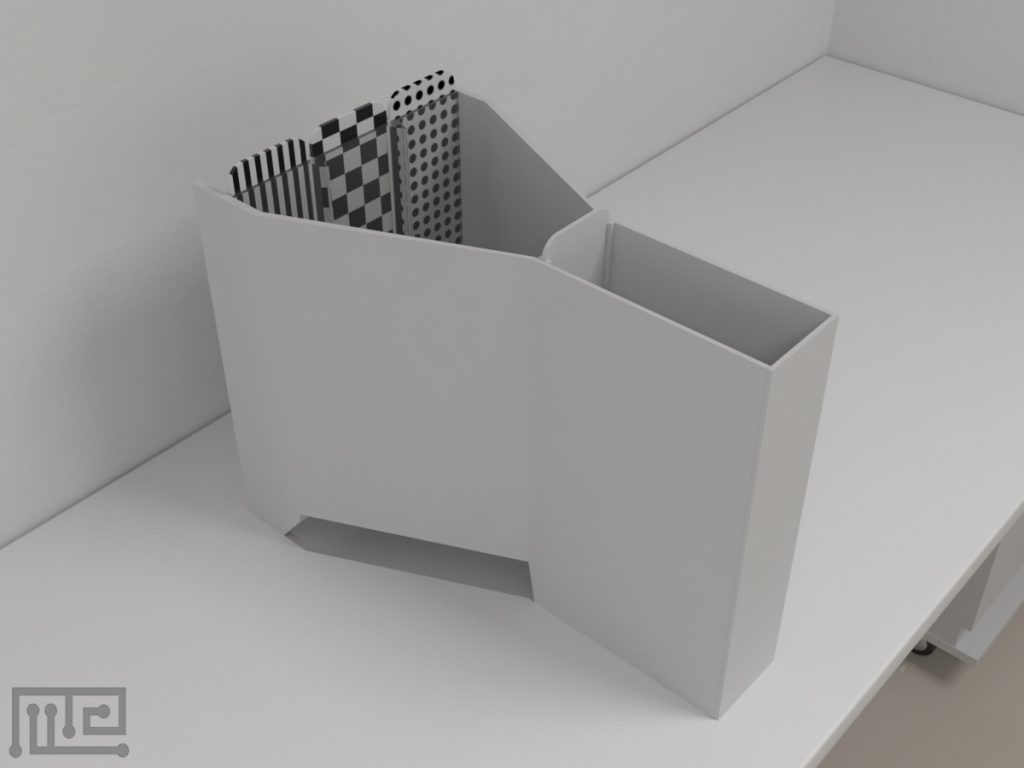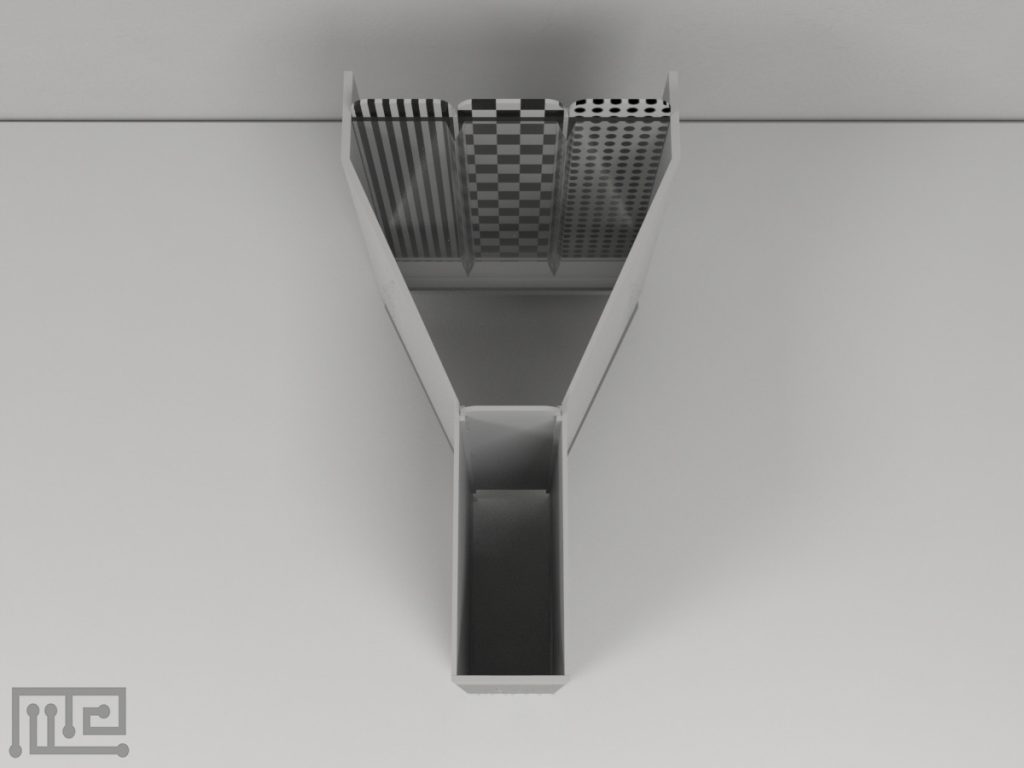The Oddity Discrimination Apparatus incorporates the same considerations used to design the Y-shaped that was part of an experiment assessing how rats spontaneously discriminate purely visual, two-dimensional stimuli in tests of recognition memory and perceptual oddity.
The apparatus had high, homogeneous white walls constructed from Perspex, to prevent the rat from seeing into the room. All walls were high, and the start box, where the rat could be confined at the start of a trial had a guillotine door leading to a triangular exploration area with the stimuli being placed along the back wall.
The back wall had two wide dividers between the three wide spaces where the pictures were placed. Panels, holding one picture card each, filled each of these three spaces.
Mazeengineers offers the Oddity DiscriminationApparatus.
Price & Dimensions
Mouse
$ 1890
+S&H- Height of walls: 26.6cm
- Length of start box: 16.6cm
- Length of back wall of exploration area: 23cm
- Width of dividers: 1.3cm
- Width of spaces for pictures: 6.6cm
- Depth of recesses to accomodate objects: 6.6cm
Rat
$ 1990
+S&H- Height of walls: 40cm
- Length of start box: 25cm
- Length of back wall of exploration area: 35cm
- Width of dividers: 2cm
- Width of spaces for pictures: 10cm
- Depth of recesses to accomodate objects: 10cm
Documentation
Introduction
The Oddity Discrimination Apparatus is used in the assessment of recognition memory and preference for novelty in rodent animal models. The apparatus design is based on the Y-Maze apparatus, with the exception that instead of forking into two choice arms, the start box leads to a triangular exploration area.
Rodent cognition tasks such as the Morris Water Maze or the Radial Arm Maze consists of more than just visual stimuli. However, the Oddity Apparatus involves tasks that are purely in the visual domain to assess cognition in rodents. Since humans rely heavily on visual information, the use of a purely visual task using the Oddity Apparatus improves animal behavioral models of human cognition. Further, the Oddity Discrimination Apparatus task, unlike other tasks, does not require extensive training of the subjects, thus allowing the use of the apparatus for high-throughput applications. The Oddity DiscriminationApparatus task provides the subject with the option to choose and explore novel and familiar visual stimuli. These explorative behaviors provide insights into the cognitive processes involved and in the evaluation of the effects of memory and learning impairments on the preference behaviors. Though the task is usually applied using 2D visual stimuli placed in the placard slots in the wide end of the exploration area, it can be easily adapted to assess behaviors using 3D objects. The back wall of the exploration area can be replaced with a recessed section to accommodate object stimuli.
Other apparatuses also used in the assessment of novelty preference, choice behaviors, and exploratory behaviors include the Novel Object Assay, the Novel Object Recognition Apparatus, the Continuous Novel Object Recognition Apparatus, the Bowtie Maze, the Open Field, and the T-Maze.
Apparatus and Equipment
The Oddity Discrimination Apparatus is constructed using opaque acrylic. The apparatus consists of a 25 cm long start box that is separated from the exploration area by a guillotine door. The exploration area opens up from the narrow start box into a triangular arena with the back wall (wide end) measuring 35 cm in width. The wall is divided using 2 cm thick dividers to create 3 sections each 10 cm wide. Each section is equipped with panels to hold a visual card. Additionally, the back wall can be replaced with a 10 cm deep recess to hold objects. All walls of the apparatus measure 40 cm high and prevent the subjects from jumping over or accessing any external visual cues.
Training Protocol
Illuminate the maze using overhead lighting to ensure even illumination inside the apparatus. Wipe the maze between trials. However, in the case of saturating the apparatus with odors, washing the apparatus is not necessary. Wipe the stimulus (objects/visual cards) used in the apparatus using a 50% solution of ethanol between trials. Tracking and recording of the performances in the Oddity Apparatus can be assisted using an automated tracking and recording system such as the Noldus EthoVision XT.
Habituation
Perform habituation trials without any stimulus in the Oddity Apparatus. Place the subject in the start box with the guillotine door closed. Open the guillotine door and allow the subject to explore the apparatus for 5 minutes. Close the guillotine door once the subject leaves the start box. Repeat trial the following day for a total of 2 habituation sessions.
Oddity Discrimination Apparatus Task
Begin testing 24 hours after the last habituation session. Place the stimuli in the apparatus. Introduce the subject into the start box with the guillotine closed. Open the guillotine door to begin the trials. Once the subject leaves the start box, close the guillotine door to prevent reentry into the start box. Allow the subject to explore the apparatus and stimuli for 5 minutes. Perform one trial per day. Test each set of stimulus in blocks of four days with 3-day rest periods between each block.
Evaluation of purely visual spontaneous object recognition and spontaneous oddity preference
Forwood, Bartko, Saksida, and Bussey (2007) evaluated recognition memory and perceptual oddity in naive adult male Lister hooded rats using a purely visual testing set-up. Performances were evaluated in the Oddity Apparatus and a Modified Y-Maze using picture cards, 2D patterns, 2D shapes, and 3D objects as stimuli. The subjects were observed to show a significantly higher preference for objects among all the stimuli sets tested in the Oddity Apparatus. Among the 2D stimuli, photos were explored more than shapes and patterns, both of which were equally explored by the rats. When tested in the Modified Y-Maze for recognition memory, rats displayed robust novelty preferences during 2D picture pair tests. However, when evaluated using 3D objects, rats displayed higher exploration levels as opposed to when tested using 2D pictures.
Evaluation of the role of perirhinal cortex in perceptual oddity task
Bartko, Winters, Cowell, Saksida, and Bussey (2007) subjected perirhinal cortex lesioned, naïve Lister hooded rat to a configural oddity test using the Oddity Apparatus. Subjects either underwent perirhinal cortex lesioning using injections of 0.2 µL of 0.9 M NMDA or only a craniotomy (Sham group). The rats were presented with a total of 5 object pairs simultaneously during the task either under control conditions (EF and GH object pairs) or configural conditions (CB and AD object pairs). The pairings were composed of two copies of one object pair, two copies of a different object pair, and one copy of odd object pair (AB object pair). Unlike the control conditions, rats in the configural condition had to identify novel pair by using the elemental feature along with the conjunction feature. Both rat groups displayed similar levels of total exploration duration during both test conditions. Analysis of oddity preference revealed a significant effect of the test condition. The perirhinal cortex lesioned group displayed significant impairment in the configural condition as compared to the sham group. Though no significant group effect could be observed, a significant group by condition interaction could be observed in the tasks.
Data Analysis
The following behaviors and measures can be observed in the Oddity Discrimination Apparatus
- Total exploration duration
- Total stimuli exploration duration
- Time spent exploring odd stimulus
- Time spent exploring repeated stimulus
- Changes in exploration behavior within a block
Strengths and Limitations
Strengths
The Oddity Discrimination Apparatus evaluates rodent cognition in the visual domain, which bridges the gap between rodent tests and human tests of cognition. The apparatus has a simple, straightforward design that can be easily adapted for different investigatory needs. The start box helps in reducing novelty stress in addition to allowing the introduction of delays in combination with the guillotine door. The back end of the exploration area can be swapped out for a recessed area to hold 3D objects instead of visual cards. The task in the Oddity Apparatus does not require any or minimal pretraining, thus making it time-efficient. The apparatus also does not necessarily require cleaning to remove any odors since odor saturation does not affect the performances.
Limitations
Cleaning of the objects or other visual stimuli used is important to prevent any lingering odors from affecting explorative or choice behaviors in the subjects. Subjects performances may be influenced by their age, gender, and species. Since Oddity Discrimination Apparatus task purely relies on vision, subjects with any vision-related impairments may not perform as expected.
Summary
- The Oddity Discrimination Apparatus is used in the assessment of oddity preference in rodents.
- The Oddity Discrimination Apparatus task bridge the gap between rodent and human tests of cognition by being purely visual in their set-up.
- The start box and the guillotine door allow the introduction of task delays.
- The Oddity Discrimination Apparatus tasks do not require pretraining or removal of odors from the apparatus.
- The removable backend of the exploration area allows accommodation of either visual cue cards or 3D objects.
References
- Bartko, S. J., Winters, B. D., Cowell, R. A., Saksida, L. M., & Bussey, T. J. (2007). Perirhinal cortex resolves feature ambiguity in configural object recognition and perceptual oddity tasks. Learning & Memory, 14(12), 821–832. doi:10.1101/lm.749207
- Forwood, S. E., Bartko, S. J., Saksida, L. M., & Bussey, T. J. (2007). Rats spontaneously discriminate purely visual, two-dimensional stimuli in tests of recognition memory and perceptual oddity. Behavioral Neuroscience, 121(5), 1032–1042. doi:10.1037/0735-7044.121.5.1032




